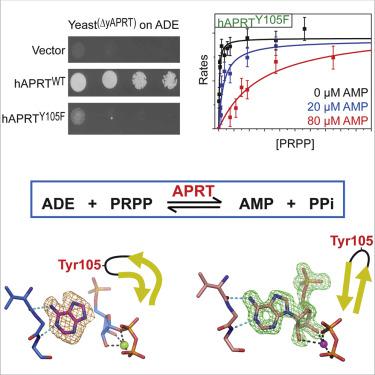Structural Insights into the Forward and Reverse Enzymatic Reactions in Human Adenine Phosphoribosyltransferase
Jessica Huyet, Mohammad Ozeir, Marie-Claude Burgevin, Benoît Pinson, Françoise Chesney, Jean-Marc Remy, Abdul Rauf Siddiqi, Roland Lupoli, Gregory Pinon, Christelle Saint-Marc, Jean-Francois Gibert, Renaud Morales, Irène Ceballos-Picot, Robert Barouki, Bertrand Daignan-Fornier, Anne Olivier-Bandini, Franck Augé, Pierre Nioche
文献索引:10.1016/j.chembiol.2018.02.011
全文:HTML全文
摘要

Phosphoribosyltransferases catalyze the displacement of a PRPP α-1′-pyrophosphate to a nitrogen-containing nucleobase. How they control the balance of substrates/products binding and activities is poorly understood. Here, we investigated the human adenine phosphoribosyltransferase (hAPRT) that produces AMP in the purine salvage pathway. We show that a single oxygen atom from the Tyr105 side chain is responsible for selecting the active conformation of the 12 amino acid long catalytic loop. Usingin vitro, cellular, andin crystalloapproaches, we demonstrated that Tyr105 is key for the fine-tuning of the kinetic activity efficiencies of the forward and reverse reactions. Together, our results reveal an evolutionary pressure on the strictly conserved Tyr105 and on the dynamic motion of the flexible loop in phosphoribosyltransferases that is essential for purine biosynthesis in cells. These data also provide the framework for designing novel adenine derivatives that could modulate, through hAPRT, diseases-involved cellular pathways.
|
Cellular Cyborgs: On the Precipice of a Drug Delivery Revolu...
2018-04-05 [10.1016/j.chembiol.2018.03.003] |
|
The Rheumatoid Arthritis-Associated Citrullinome
2018-04-05 [10.1016/j.chembiol.2018.03.002] |
|
Dependence on the Pyrimidine Biosynthetic Enzyme DHODH Is a ...
2018-04-05 [10.1016/j.chembiol.2018.03.005] |
|
The O-GlcNAc Transferase Intellectual Disability Mutation L2...
2018-03-29 [10.1016/j.chembiol.2018.03.004] |
|
Targeting Phosphopeptide Recognition by the Human BRCA1 Tand...
2018-03-29 [10.1016/j.chembiol.2018.02.012] |